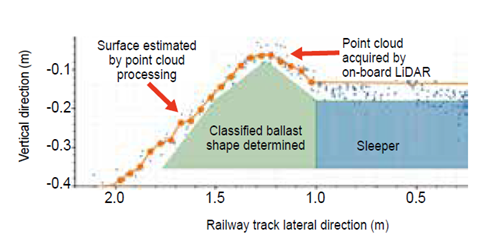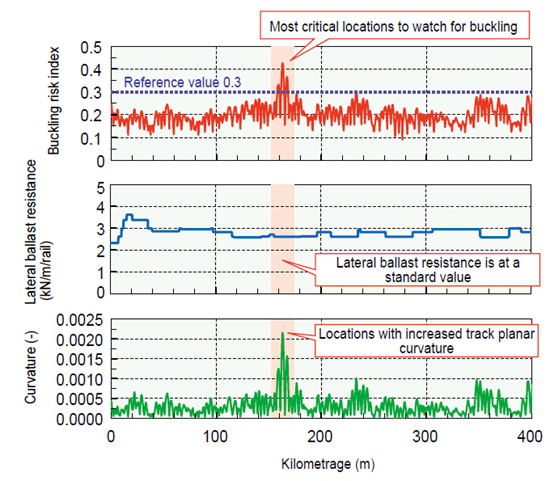3. Method for Estimating Track Buckling Risk Based on On-board Measurements
To prevent track buckling during extreme summer heat with a limited number of maintenance workers, it is essential to develop an efficient method for identifying locations where buckling is likely to occur. To address this, we developed a method to estimate buckling risk based on on-board measurements. Specifically, the buckling risk is assessed by combining the estimated reduction in lateral ballast resistance due to insufficient ballast at the track bed shoulder and unsupported sleepers together with the influence of track irregularity.
To identify areas with insufficient ballasts at the track bed shoulder, we developed a method to estimate the ballast shape using LiDAR sensors mounted on the train (Figure 1). The expected lateral ballast resistance based on the identified ballast shape is estimated using the limit equilibrium method. Model testing has confirmed that this method can predict the resistance with an error of approximately 10% for standard ballast shapes and about 20% for areas where sleeper ends are exposed (Figure 2). In addition, since no lateral ballast resistance is provided by the underside of sleepers in areas where unsupported sleepers are present, the estimated lateral ballast resistance is corrected based on the amount of hanging estimated from vertical level irregularity data obtained through track measurements.
As an indicator to identify locations with relatively high risk of buckling, we proposed a new metric called the “buckling risk index.” This index is calculated based on the estimated lateral ballast resistance and the planar curvature of the track. This processing method was developed using the command set of signal processing system for track maintenance and management (LABOCS), allowing the buckling risk index calculated from the rail temperature rise at which buckling may occur to be visualized on a chart for review (Figure 3).
This method enables the identification of critical locations where the buckling risk index exceeds 0.3 and facilitates the planning of maintenance activities prior to the peak heat season, when buckling is more likely to occur, thereby enhancing safety.
Other Contents
- 1. Performance Evaluation Method for Earthquake Early Warning Systems
- 2. Method for Setting Regulation Values for Operation Control Under Rainfall Using Radar Rain Gauges
- 3. Method for Estimating Track Buckling Risk Based on On-board Measurements
- 4. Method for Identifying Wheel Usage Limit Temperature and Evaluating Safety While in Service
- 5. Investigation of Front Rod Fracture Causes and Maintenance Methods to Prevent Fracture
- 6. Detection System for DC High-resistance Ground Faults by Utilizing the Current Data of Both Substations and Vehicles
- 7. Forward Obstacle Detection System for Trains in Preparation for Future Driverless Operation
- 8. Validation of the Long-term Effectiveness of Automatic Deerdeterrent Sound Devices
- 1. Performance Evaluation Method for Earthquake Early Warning Systems
- 2. Method for Setting Regulation Values for Operation Control Under Rainfall Using Radar Rain Gauges
- 3. Method for Estimating Track Buckling Risk Based on On-board Measurements
- 4. Method for Identifying Wheel Usage Limit Temperature and Evaluating Safety While in Service
- 5. Investigation of Front Rod Fracture Causes and Maintenance Methods to Prevent Fracture
- 6. Detection System for DC High-resistance Ground Faults by Utilizing the Current Data of Both Substations and Vehicles
- 7. Forward Obstacle Detection System for Trains in Preparation for Future Driverless Operation
- 8. Validation of the Long-term Effectiveness of Automatic Deerdeterrent Sound Devices



